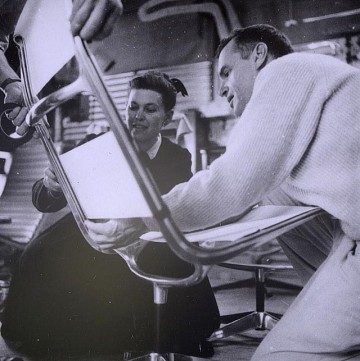
Development of Aluminum Chairs, with Ray and Charles at left, circa 1958, photograph from Library of Congress.
While interest in the work of Charles and Ray Eames remains high, this fall it seems to be peaking: there are countless exhibitions, projects, publications, and auctions that will feature their work, or projects inspired by them. At the Indianapolis Museum of Art, I have been working with Tricia Gilson, Ball State University professor and independent researcher, to study the Eames material contained within the Eero Saaranin-designed Miller House and Garden, located in Columbus, Indiana.
Although the Miller House and Garden opened just this year, we’ve already had a lot of scholarly interest in it and its mid-century modern contents. One of the most memorable and knowledgeable visitors we’ve had recently was Daniel Ostroff, who came with some folks from Herman Miller to look at the furnishings in the house.
To expand on the conversations we had with him at the Miller House, I invited Tricia to help interview Dan about his work with the Eameses. This will be a two-part interview, with the second part coming on Tuesday.
Daniel Ostroff is a Los Angeles-based film producer, researcher, curator, and collector. He is also the producer and editor of EamesDesigns.com, a consultant for Herman Miller, and has been sitting on an Equa Chair behind an Action Office System desk for the past 10 years.
Today the exhibition he curated, Collecting Eames: The JF Chen Collection, opens at JF Chen in Los Angeles. The exhibition is part of the Getty’s massive Pacific Standard Time project and consists of 450 pieces, with a corresponding 135 page catalog with a preface by Eames Demetrios and an essay by Dan (available soon on Amazon, or by e-mail here). Also, next month Dan will have an Eames-related book out and another in 2012.
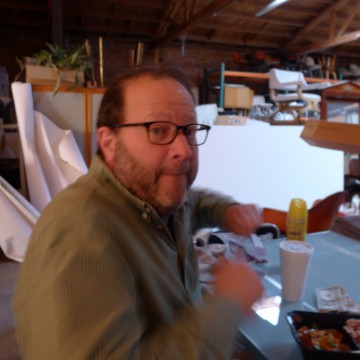
Daniel Ostroff in his favorite place in all of Los Angeles, The JF Chen Storage and Study Area. Photo by Grant Taylor.
Richard McCoy and Tricia Gilson: How did you first start collecting and researching the work of Charles and Ray Eames?
Daniel Ostroff: I am a film producer now, but I was a Hollywood agent before that. In 1987 I opened The Daniel Ostroff Agency in Los Angeles, an agency for screenwriters, directors, and books to film. While I had worked before that as an agent, I had either worked for other companies or with a partner.
With my own office I was faced with the prospect of having to furnish the place. I started with rented furniture, and then an artist friend came to visit. He pointed out that given the business that I was in, rented furniture wouldn’t do, and so I asked him what I should get. He replied with a question: “Why buy furniture that depreciates in value?” He told me about a rare Eames desk for sale in San Diego, and my journey began.
I bought that desk for a couple thousand dollars. I also made my first collector’s mistake with it: I didn’t listen to the dealer, who was experienced and knowledgeable. There was some rust on the steel frames, and I insisted that he re-chrome it. I wasn’t happy with the results; it was an early lesson in how you should appreciate antique furniture for its honest signs of age.
Eventually my collection expanded, and at one point, I had fantastic examples of designs by all of the greats, particularly from the period 1946 to 1989. My collection encompassed both post-war modernism, and post-modern designs.
At one point, I had a living room full of great vintage George Nakashima case goods, a rare Eames 3473 Sofa Compact, a Finn Juhl Chieftain Chair, an Achille Castiglioni San Luca Lounge Chair, a Ron Arad Rover Chair, and a Hans Wegner Peacock Chair. Throughout my place were classic Ettore Sottsass designs, too: lighting, case goods, ceramics and enamels.
But the more I collected and the more I learned about design and designers, the more I focused on Eames. Finally, it was only Eames designs that I couldn’t live without.
RM & TG: And today, you’ve produced and continue to edit the fantastic web resource, EamesDesigns.com, which is a “A Virtual Encyclopedia of all things Eames.” What was the impetus behind starting this web project?
DO: I made that site in collaboration with the Eames family (and with support from the Eames Office), who carry on the legacy of Charles and Ray Eames. The family is very active in carefully supervising the ongoing production of authentic Eames designs, but just as importantly they embody and exemplify their grandparent’s best attributes.
Charles and Ray did not believe in the “gifted few” concept. They thought that many of us could do good work, if we care about what we are doing, and are given a chance to try and try again. The Eames family first did this with me when they asked me to write the book Modern Classic: the Eames Plastic Chair. Following on that, they asked me to be their in-house vintage Eames expert, and even though Eames Demetrios very kindly called me a “scholar” when I did that first book, I wasn’t then, but they allowed me to try and learn. For the next five years I answered vintage Eames questions, and I’ve done a fair amount of trying and trying again.
I actually feel that studying Eames designs is a moral imperative. I got my first clue of this when I read something that the great graphic designer, Milton Glaser, said about Charles and Ray: he said words to the effect of, “Charles and Ray Eames showed us all that a design office could have a moral center.” And as you study what they did, what they designed, and how they went about designing it, and the depth to which they thought about not only the user of the design, but also the men and women who would be producing their designs, you really understand that Milton Glaser was understating the case.
So after answering Vintage Eames questions for five years, the Eames family felt I was ready for a standalone web site, and they paid for its architecture, by the great design studio t-Sign. By this time I no longer thought of myself as a “vintage Eames” person and I did not think a “vintage Eames” site was what the world needed.
So with support from Eames Office I made Eamesdesigns.com, a virtual encyclopedia of all things Eames. I say “all things,” because another thing you learn in Eames scholarship is that, to paraphrase Charles, “The process is always the same.” The design of a film, the design of a toy, the design of a chair, they followed the same process.
There’s another point to this website, it’s not that folks should only study Eames the way they study historical things: it’s that the Eames message is current and ongoing.
RM & TG: So in what way is the study of Eames designs a moral imperative?
DO: Charles and Ray were business people. Towards the end of their lives they liked to refer to themselves as “tradesmen.” People would come to them with problems, and pay them to solve those problems, and also pay them to design products to be manufactured for a profit. But even though they were in business, and they made money performing a service, and they made money designing goods which were sold for a profit and they got royalties, they never did this without thinking about the impact of their work on society as a whole.
They did not make designs without considering what it would be like for the worker on the assembly line. They did not work without considering every possible aspect of the user experience, and not just the user experience for the first few days after you get a product home, but what it’s like to own that product ten years later. They also lived good lives, because they only would work on projects and products that they personally enjoyed—another imperative for them.
The last cars Charles and Ray Eames drove were a Jaguar and a Mercedes. They lived a rich full life, lived in a great house with a really big yard, owned their own business, traveled all over the world, and had many friends. Is that so bad? They had five beautiful grandchildren. But they did not do it at the expense of society as a whole.
Charles and Ray Eames felt that fun is as an important part of life as just about anything is. I think the world would be a better place if business men and women considered whether they really enjoy what they are doing.
Charles and Ray Eames and their manufacturing partners made money giving folks good products that are a good value for the money. We ought to apply the Eames way of thinking to business more, instead of rewarding executives for firing employees. Herman Miller does very well selling Eames designs, and yet they are often ranked as one of the 100 best companies to work for in America.
RM & TG: Why did you decide to put the Eames Encyclopedia online instead of as a book?
DO: When Eames Demetrios asked me why I wanted to do this Eames encyclopedia online, instead of as a book, I told him I wanted it online as an “encyclopedia” for several reasons:
- Folks understand that encyclopedias get updated, and this one will and can be continuously updated.
- Encyclopedias have many contributors; I hope the world of scholars will participate in this ongoing project.
Some might find it odd that scholarship is being done on a site presented by a for-profit business, the Eames Office, but actually, that is consistent with the work of the Eames Office when Charles and Ray were alive, and this is just one of many areas of discovery that unfolded for me when studying Eames work.
I’m going to need the help of everyone in the scholarly communities: the museums, universities, collectors, and the knowledgeable dealers, to continue in the high standards of scholarship set by Charles and Ray Eames, with this scholarly site.
RM & TG: Where did you get all of the objects that are photographed on the website?
DO: Just as supportive as the Eames family in this project is the JF Chen family: Joel Chen, Margaret Chen, Bianca and Fiona, who bought a collection of Eames material, grew it, and subsidized my work studying the collection the way that Charles Eames said is the best way to study design: by photographing it. (The photographer for this project was Grant Taylor, who does really great work).
Actually, The JF Chen Eames Collection started out as my personal collection. Eventually it had grown to 175 Eames pieces, and my storage bills were higher than my rent. The Chens bought the collection and grew it to 400-plus pieces. As you mentioned in the introduction, this collection is the basis of the exhibition, Collecting Eames: The JF Chen Collection.
RM & TG: Will you describe the J.F. Chen Eames Collection?
DO: The JF Chen Collection is the most extraordinary Eames collection in the world because it shows great examples from every decade of Eames design production, and it is in that chronology that you can find many of the most important messages, including the moral ones.
That collection starts with the Kleinhans Chair of 1939, by Charles Eames and Eero Saarinen, and includes an amazing high back Relaxation Chair, from the landmark 1941 Organic Design competition at MoMA. The last chair in the timeline is a 1998 La Chaise.
If you go to see this exhibition, you’ll also see an earlier Eames-Saarinen design, an incredibly rare 1939 desk they designed for the Crow Island School, which is on loan to JF Chen for the duration of the exhibition.
The importance of this collection and the Chen family’s contribution to world design history can be seen on EamesDesigns.com, because they generously donated 6000 photos to the site: photos that they paid for as I studied this collection over a period of four years.
RM & TG: In your book, Modern Classic: the Eames Plastic Chair, you write about the Eames’ desire to continue to improve on their designs. From a collector’s perspective, how do the changes in the material of the plastic chair influence notions of connoisseurship?
DO: Let’s take for example one small aspect of an Eames chair, the shock mounts: those rubber elements that are used to attach the chair’s legs to its body. Shock mounts represent on a small scale something that Charles and Ray always did: they always looked to improve upon their past work, to make something better, and their improvements were always in favor of the consumer.
The very first shock mounts were solid rubber, and there was no screw involved (just adhesive). We see that on chairs in the famous Barclay Hotel show of 1945, and then in the MoMA exhibition of spring 1946, New Furniture Designed by Charles Eames. I once owned a rare chair that was exhibited in that MoMA show which had survived with its shock mount intact. It was a miracle that this shock mount didn’t come off!
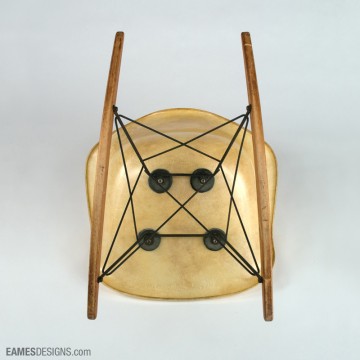
The underside of a RAR 1950 showing early shock mounts from the JF Collection, copyright Eames Office. Photograph by Grant Taylor.
The next iteration involved a screw, and an external metal plate. The metal plate had to be machined separately and this involved added cost, but it was necessary in order to give the screw a secure hold. In the next step, the Eameses came up with a way to make the metal bit integral to the rubber. And with this final step, they gave a better looking product, and one that would cost less to make. Charles and Ray were always about passing the savings along to their customers.
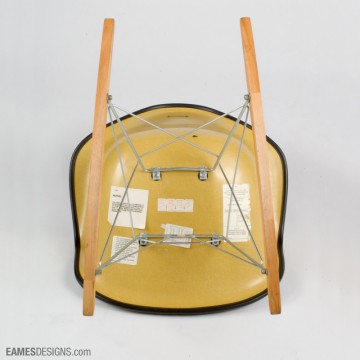
The underside of a RAR 1950 showing later shock mounts from the JF Collection, copyright Eames Office. Photograph by Grant Taylor.
The first shock mount was interesting, but ultimately couldn’t hold up under a lot of use, but when you study Eames designs closely, you learn that there is one consistent thread, that they were designed with easily repairable, easily replaceable parts. The shock mount is a classic example of this practice. Plenty of Eames chairs from the 1940s and 1950s have survived until today with intact shock mounts. Those that need new shock mounts are relatively easy to fix. What other consumer products from 1946 still look so good, work so well, and are so easy to repair?
RM & TG: This is the end of part 1, but in the meantime, check out this great video introduction to Charles and Ray Eames narrated by Gregory Peck that was written and produced by Eames Demetrios, or this Ted Talk, also by Eames Demetrios:

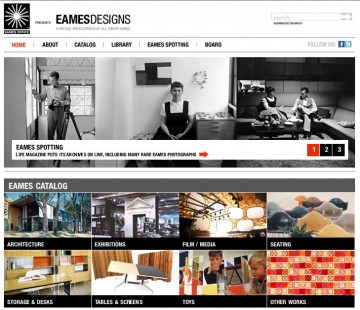


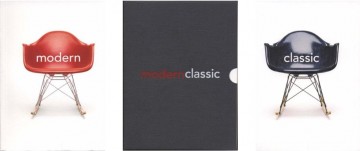



Pingback: The Top Ten U.S. Online Contemporary Conservation Projects from 2011 | Art21 Blog
Pingback: Inspiration and the Eames | Indianapolis Museum of Art Blog
Pingback: The best of design from your desk: get lost in online catalogues and encyclopedias « le blog